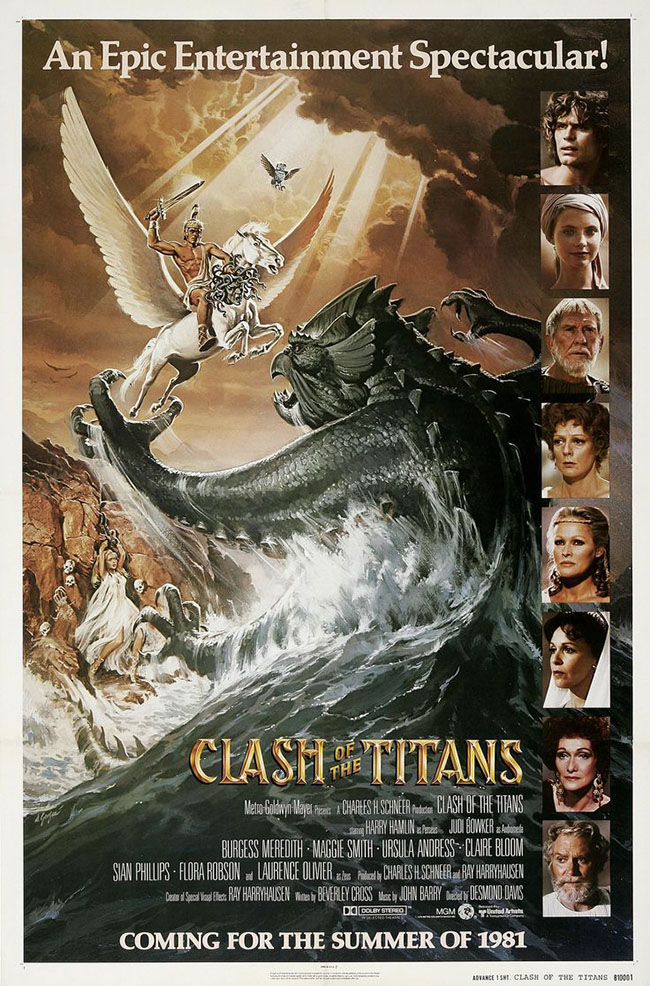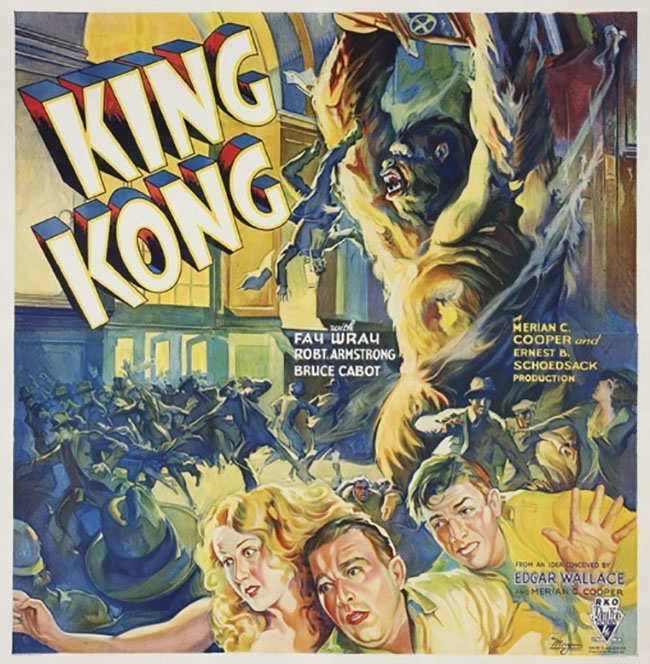
The recent arrival of Indicator’s Sinbad Trilogy box set, collecting the three Sinbad films with special effects by Ray Harryhausen, and Indicator’s subsequent announcement of the forthcoming The Wonderful Worlds of Ray Harryhausen Volume 1 (It Came from Beneath the Sea, 20 Million Miles to Earth, and The 3 Worlds of Gulliver will be included), make this a very good year for fans of stop motion. And with no better excuse I’m proposing another of my 24 Hours of Film marathons: the theme this time is creatures brought to life through the art of stop motion animation.
The medium of animating three-dimensional models one frame at a time evolved from the early years of cinema, with examples dating back as far as 1897. In Russia, animator Ladislas Starevich earned praise with films like The Grasshopper and the Ant (1911) and The Cameraman’s Revenge (1912); after moving to Paris he made a full-length stop motion feature, the very amusing The Tale of the Fox (Le Roman de Renard, 1937). In America, Willis O’Brien commenced his career with experimental short films including the proto-Flintstones comedies The Dinosaur and the Missing Link (aka The Dinosaur and the Baboon, 1915) and R.F.D. 10,000 B.C. (1917), then contentiously collaborated with Herbert M. Dawley on The Ghost of Slumber Mountain (1918). Dawley followed this up with another prehistoric-themed film, Along the Moonbeam Trail (1920).
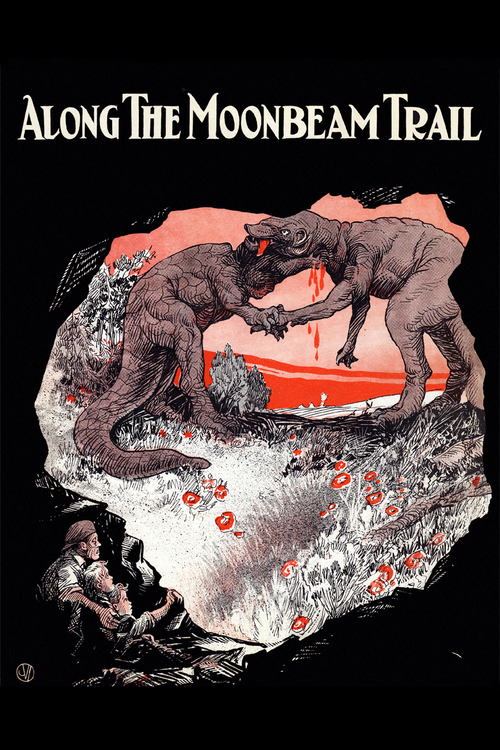
But using stop motion as a special effect had its mainstream breakthrough with the Sir Arthur Conan Doyle adaptation The Lost World (1925), directed by Harry O. Hoyt and featuring O’Brien-manipulated dinosaurs. This hit set the stage for O’Brien’s involvement in the seminal King Kong (1933) after an attempt at a film called Creation fell apart following a long development process. The colossal success of King Kong ought to have triggered a wave of stop motion imitators, but the only clear successor was an immediate, rushed sequel, Son of Kong (1933), released mere months after the original and pretty weak tea by comparison. One of the young viewers deeply impressed by King Kong was Harryhausen, who began his own at-home experiments with stop motion animation before presenting his work to O’Brien. After working with George Pal on the Puppetoons series, Harryhausen finally had an opportunity to work with O’Brien on another giant ape movie, Mighty Joe Young (1949), and developed as an FX artist through his monsters-on-the-rampage films of the 1950’s before maturing with the full color fantasy spectacle of The 7th Voyage of Sinbad (1958). The rest of his work up through his swan song, Clash of the Titans (1981), is distinctive, sophisticated, and fun. On his heels came other stop motion animation artists including Jim Danforth (When Dinosaurs Ruled the Earth) and Phil Tippett, who refined a “go motion” process to create motion blur in the model animation, notably in The Empire Strikes Back (1980) and Dragonslayer (1981). While the technique as a special effect began to fade in popularity with the advent of CG in the late 80’s and early 90’s, fully stop motion features in the tradition of Starevich continued up through Will Vinton’s Claymation specials and his feature The Adventures of Mark Twain (1985) through the work of Henry Selick (Coraline, The Nightmare Before Christmas) and others.
But for this proposed film marathon, we’re going to be focusing on stop motion creatures and monsters in the mold of O’Brien and Harryhausen’s essential contributions to fantastic cinema.
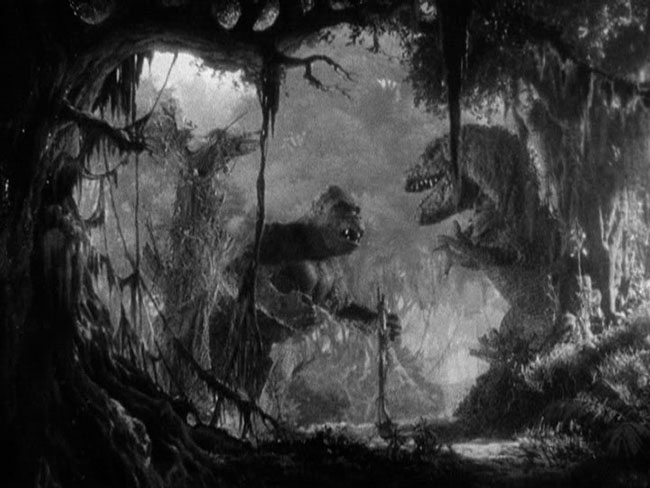
6am: King Kong (1933) D: Merian C. Cooper and Ernest B. Schoedsack
Kick off the marathon with the high water mark of the giant monster romp. Although O’Brien’s animation is not flawless – you can see the hair ripple where the animator’s fingers moved the model; his dinosaurs seem crude in comparison to Harryhausen’s later work; and the sense of scale is frequently out of whack – the handmade touch is obvious, charming, and doesn’t get in the way of the film’s palpable sense of awe. The build-up to Skull Island (which looks like it was drawn by Doré), the exploration of the jungle and the discovery of its wonders, and the white-knuckle encounters with Kong himself are all irresistible and engrossing. Fay Wray is sexy and sympathetic, and Robert Armstrong – as Carl Denham – gives a performance just as outsized as the ape he’s pursuing.
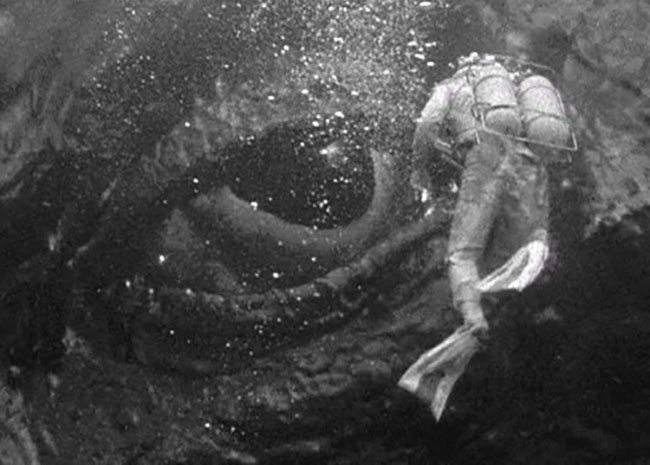
8am: It Came from Beneath the Sea (1955) D: Robert Gordon
Everything about this giant-octopus-on-the-rampage B-movie is typical of the genre for the 1950’s (square-jawed hero, pretty female scientist, scattered attacks from an overgrown creature followed by a hunt and a climactic encounter), with one exception: the excellent special effects are fully animated by Ray Harryhausen. This lends a sense of excitement to the expected scenes of vast tentacles uncoiling from beneath the waves and smashing ships or knocking sailors into the sea. The finale of course required a recognizable monument to be destroyed, and here it’s the Golden Gate Bridge. The fact that the cephalopod is never seen in full allows Harryhausen to hide the fact that he only built six tentacles for his armature, not eight. And though the script is strictly the basics, the leads – Kenneth Tobey (The Thing from Another World) and Faith Domergue (This Island Earth) – are very appealingly cast.
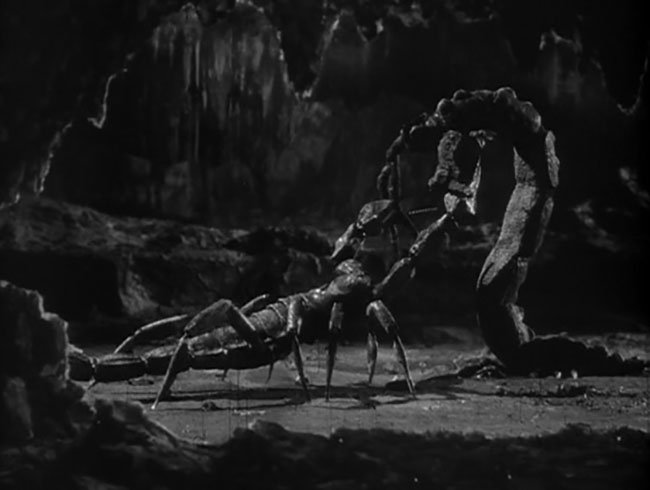
9:30am: The Black Scorpion (1957) D: Edward Ludwig
The Black Scorpion has a poor reputation thanks to its inclusion in the first season of Mystery Science Theater 3000, but it’s actually slightly above average for its genre – again, it’s thanks to the high quality of the special effects. Willis O’Brien had seen one proposed project after another crash and burn following Mighty Joe Young, and so it’s a joy to see him at work again in The Black Scorpion, a film that’s about, of course, giant scorpions stirring mayhem. The human characters are of secondary concern – and barely so (Richard Denning, who appeared in The Creature from the Black Lagoon, is the lead here). Of particular interest is a scene set in the scorpions’ lair inside a volcano, which seems to be O’Brien’s opportunity to revisit the concept of the Spider Pit, the infamous scene cut from King Kong and subsequently lost to history. While monster kids dream of one day discovering the Spider Pit scene, they’d do well to revisit The Black Scorpion for a glimpse of what it might have looked like.
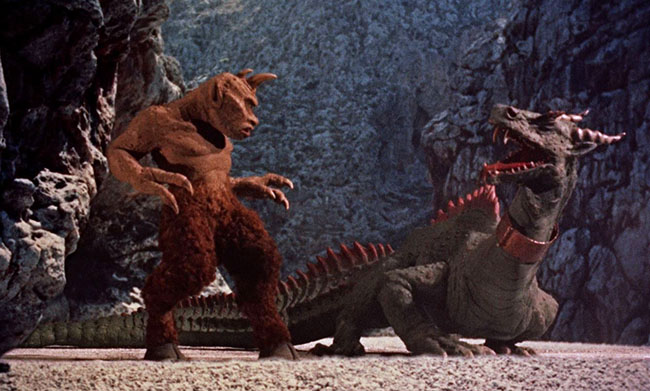
11am: The 7th Voyage of Sinbad (1958) D: Nathan Juran
Harryhausen and producer Charles H. Schneer launched the promo gimmick “Dynamation” (still just stop motion animation) with this Technicolor widescreen Arabian Nights fantasy. As with King Kong, there is not just one monster, but a whole bestiary worthy of a fantasy spectacle: a one-eyed cyclops with cloven feet; a dragon; the dancing snake-woman; the two-headed Roc and its vengeful mother; and, perhaps most impressive of all, a reanimated skeleton which lifts a sword and shield to duel with Kerwin Mathews’ Sinbad the Sailor. This raised the bar for the art form, and only Harryhausen would be the one to top himself. It formed a template for later spectacles like Jason and the Argonauts and Clash of the Titans.
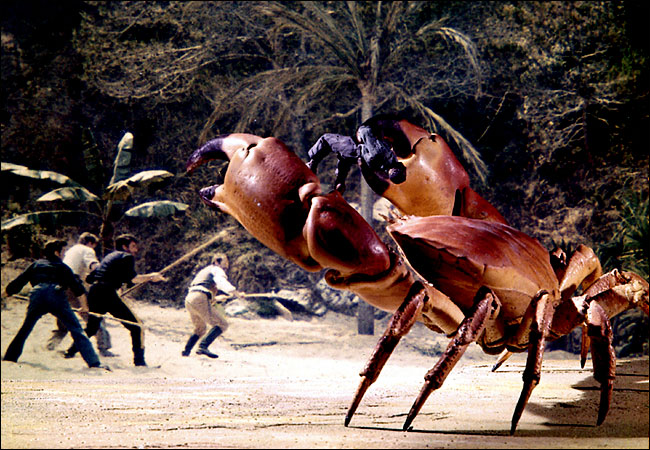
12:30pm: Mysterious Island (1961) D: Cy Endfield
Harryhausen took on Jules Verne with this very liberal adaptation of the novel Mysterious Island, adding a subplot with the isolated Captain Nemo (Herbert Lom, A Shot in the Dark) experimenting and creating oversized creatures, like a giant crab, giant bees, and a prehistoric bird (the Phorusrhacos). Battling these beasts is a group of castaways – Union soldiers fleeing a Confederate prison with a hot air balloon, and a pair of British women (Joan Greenwood and Beth Rogan) washed up following a shipwreck. Add pirates to this mix and this is the perfect matinee adventure.

2:30pm: Jason and the Argonauts (1963) D: Don Chaffey
Harryhausen’s supreme masterpiece captures the sense of awe present in King Kong and expands that feeling to encompass an entire imagined world drenched in Greek mythology. Jason (Todd Armstrong) guides his Argonauts from one dangerous island to another in search of the Golden Fleece, encountering harpies, the bronze giant Talos, crashing rocks, the deadly multi-headed Hydra, and – most impressive of all – a squad of sword-wielding skeletons, perfectly choreographed with the live action footage to easily top the duel in The 7th Voyage of Sinbad. As with 7th Voyage, The 3 Worlds of Gulliver, and Mysterious Island, the imaginative score is by Bernard Herrmann at the top of his game. It would be his final collaboration with Harryhausen.
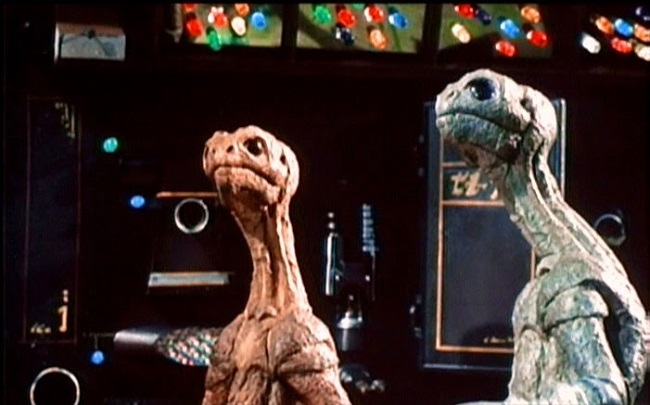
4:30pm: Laserblast (1978) D: Charles Band
After a heaping helping of Harryhausen, it’s time for something a little…different. I remember renting the Charles Band-directed Laserblast as a kid and not knowing what to make of it, other than I liked the stop motion aliens. Those, by the way, are by Dave Allen, who would later receive an Academy Award nomination for his work on the special effects of Young Sherlock Holmes (1985). Allen’s turtle-like aliens are pretty much the high point of Laserblast, which, like The Black Scorpion, also appeared on MST3K (except this time it was well deserved). Kim Milford plays a disaffected, frequently shirtless teen who discovers a laser gun of extraterrestrial origin and uses it to destroy his enemies, losing his soul in the process. Of note to cult movie buffs is the welcome presence of Cheryl “Rainbeaux” Smith (Caged Heat, Lemora, Revenge of the Cheerleaders) as his girlfriend – and, yes, there’s also Eddie Deezen.
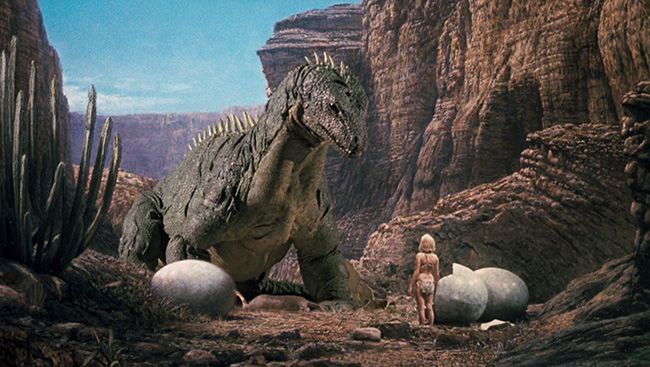
6pm: When Dinosaurs Ruled the Earth (1970) D: Val Guest
Technically Hammer’s follow-up to One Million Years BC (1966) – well, one of them – this prehistoric survivalist adventure substitutes Jim Danforth for the original’s Harryhausen. It’s a good swap. Danforth is a talented stop motion wizard, and he would collaborate with Harryhausen on Clash of the Titans. But the 70’s were an odd and unstable period for Hammer, as the studio gradually entered a decline. When Dinosaurs Ruled the Earth is one of their last films to feel like an epic, the animated dinosaurs giving the film a bigger budget look than it actually had. It also features – in its uncut international version – surprising, exploitative nudity for what would otherwise be a family picture (this is the version now available on Blu-ray from Warner Archive). Playboy model Victoria Vetri gets the Raquel Welch treatment here. The creatures are exceptionally well done.
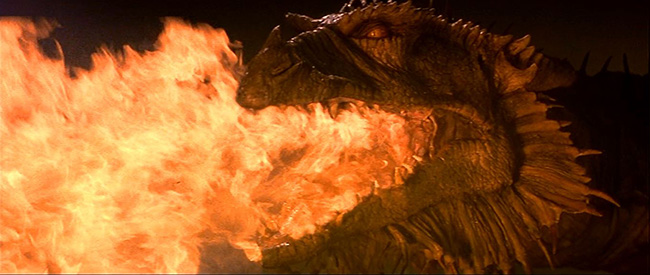
8pm: Dragonslayer (1981) D: Matthew Robbins
George R.R. Martin just named this uncharacteristically grim and gritty Disney film #5 on his top 10 fantasy films of all time. “Vermithrax Pejorative is the best dragon ever put on film,” Martin writes, and I agree completely. What is especially remarkable is that the dragon is brought to life through stop motion animation that is almost entirely seamless. This is “go motion,” a process to conjure realistically blurred movements for the animated model. Phil Tippett, a stop motion animator who would later successfully transition to CG when Spielberg wanted to test it for Jurassic Park, created his own go motion technique (moving the model during each film frame exposure with the aid of computer-programmed movements) which was put to good use on The Empire Strikes Back (1980) for the Tauntauns and AT-AT Walkers. Although Vermithrax Pejorative does not fully appear on-screen until well into the movie – only parts of him are glimpsed, building anticipation for the big reveal – once he does, the effect of blending go motion with a life-size animatronic head creates a very convincing mythical beast.
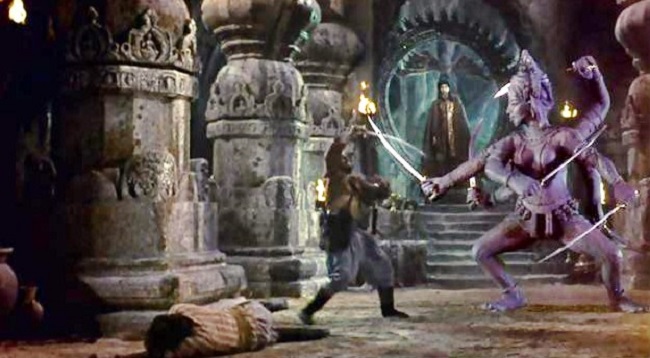
10pm: The Golden Voyage of Sinbad (1973) D: Gordon Hessler
Many Harryhausen fans consider this the best of the Sinbad trilogy, and while I disagree, I can understand the logic. Not one but three cult icons figure prominently: curvaceous Caroline Munro (Captain Kronos: Vampire Hunter, The Spy Who Loved Me) as a slave girl; Tom Baker (Doctor Who) as the villainous sorcerer Koura; and John Phillip Law (Barbarella, Diabolik) taking over the Kerwin Mathews role as Sinbad – even attempting an accent. Harryhausen’s work is exceptional as always, creating a variety of monsters as Sinbad travels to Lemuria to retrieve a piece of a magical medallion, but the highlight is the animation of the six-armed statue of Kali, which does an impressive Indian dance (Harryhausen had a model from which to work) before it sprouts six swords from its hands and duels with Sinbad and his men – an interesting variant on the Jason and the Argonauts skeleton fight. The grand score is by Miklós Rózsa (The Thief of Bagdad). My only complaint about the film is that it’s a little slow to get going.
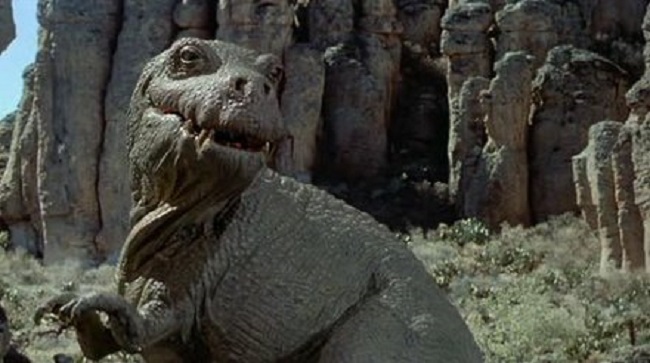
11:45pm: Caveman (1981) D: Carl Gottlieb
Ringo Starr, Barbara Bach (his wife and former Bond girl), Dennis Quaid, and Shelley Long star in this parody of films like One Million Years B.C. and When Dinosaurs Ruled the Earth – pretty much in the style of the prehistoric opening segment of Mel Brooks’ History of the World: Part I (also 1981). The tagline is: “Back when you had to beat it before you could eat it,” which sums up the film’s level of humor. The stop motion dinosaurs are by Dave Allen. This is the part of the evening where you might want to pour yourself a drink or three.
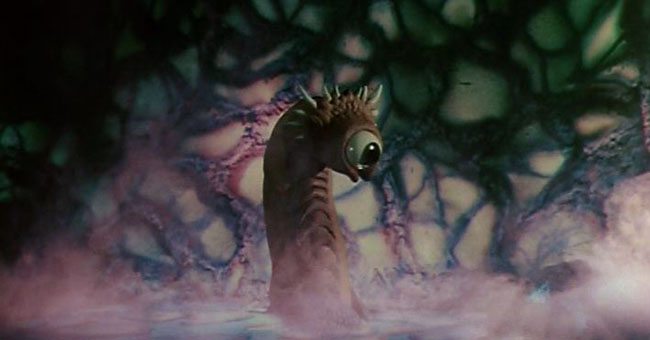
1:15am: Flesh Gordon (1974) D: Michael Benveniste and Howard Ziehm
At the height of porno chic comes this X-rated take on old Flash Gordon serials, featuring the likes of Dale Ardor, Dr. Flexi Jerkoff, and Emperor Wang the Perverted from the planet Porno…just in case you found the humor in Caveman too sophisticated. It was shot as a hardcore film, but the explicit footage was seized by Los Angeles police. After Wang’s Sex Ray turns Earth into an orgy, Flesh Gordon leaps into action to stop him. Stop motion comes into play with the arrival of the Penisauruses and the Great God Porno (named by the SFX team “Nesuahyrrah,” or “Harryhausen” spelled backwards). Dave Allen, Jim Danforth, Rick Baker, and Dennis Muren all worked on the film, giving this silly softcore parody a higher level of prestige than most.
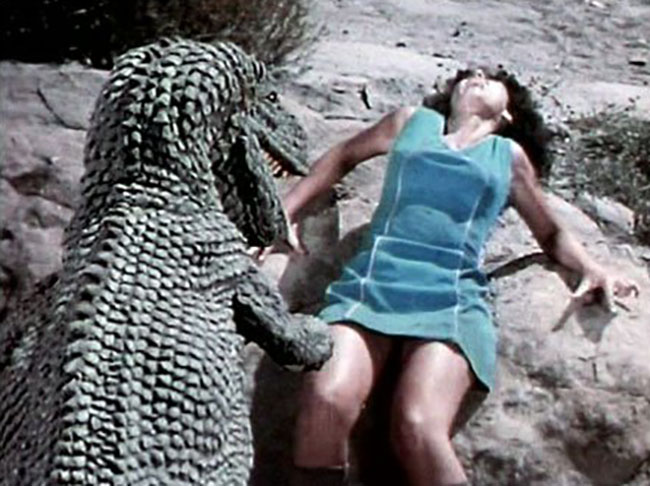
2:45am: Planet of Dinosaurs (1977) D: James K. Shea
This micro-budgeted SF adventure has a paper-thin story that’s a throwback to films like Women of the Prehistoric Planet (1966) and King Dinosaur (1955), with a spaceship crashing on a primordial world lousy with dinosaurs. While the acting doesn’t rise to the level of community theater, and the dialogue is frequently atrocious, it’s clearly a labor of love. The stop motion animation – including a host of dinos and a giant spider – is very well done, with credit to lead animator Doug Beswick, who would go on to work on The Empire Strikes Back, The Terminator (1984), and Aliens (1986). He had also contributed to Flesh Gordon (naturally). Jim Danforth is credited as the matte artist.
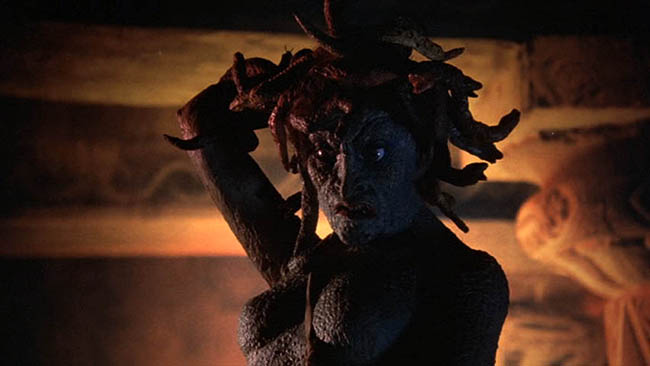
4:15am: Clash of the Titans (1981) D: Desmond Davis
Let’s go out on a high note. Clash of the Titans was the last great fantasy film to lean heavily on stop motion effects, and appropriately it was the final feature film by Harryhausen. The stalking by Perseus (Harry Hamlin) of the rattlesnake-tailed gorgon Medusa by flickering torchlight and shifting shadows introduced a new dimension to Harryhausen’s art: pure claustrophobic tension. Aided by Jim Danforth and Steven Archer, Harryhausen also brings us winged Pegasus, a colossal vulture who carries away the Princess Andromeda (Judi Bowker), a host of giant scorpions, Bubo the mechanical owl, and the four-armed Kraken. It’s infinitely better than its remake – because you can admire the craftsmanship of its handmade special effects.
* * *
An alternate 24 hour marathon (actually 26 hours) can take you through Harryhausen’s entire body of work:
6am: Fairy Tales (Mother Goose Stories, Little Red Riding Hood, Hansel and Gretel, Rapunzel, King Midas, The Tortoise and the Hare)
7am: Mighty Joe Young (1949)
8:45am: The Beast from 20,000 Fathoms (1953)
10:15am: It Came from Beneath the Sea (1955)
11:45am: Dinosaur Excerpt from The Animal World (1956)
12pm: Earth vs. the Flying Saucers (1956)
1:30pm: 20 Million Miles to Earth (1957)
3pm: The 7th Voyage of Sinbad (1958)
4:30pm: The 3 Worlds of Gulliver (1960)
6:15pm: Mysterious Island (1961)
8pm: Jason and the Argonauts (1963)
9:45pm: First Men in the Moon (1964)
11:30pm: One Million Years B.C. (1966)
1:15am: The Valley of Gwangi (1969)
2:50am: The Golden Voyage of Sinbad (1973)
4:30am: Sinbad and the Eye of the Tiger (1977)
6:30am: Clash of the Titans (1981)
